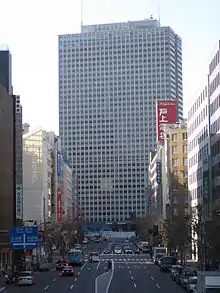Kiyoshi Mutō (武藤 清, Mutō Kiyoshi, 29 January 1903 – 12 March 1989)[1] was a Japanese architect and structural engineer. He is considered the "father of the Japanese skyscraper" for his contributions to earthquake engineering.[2]
Earthquake engineering research
Mutō was born in Toride, Ibaraki, Japan.[1] He entered the Department of Architecture at Tokyo Imperial University (now the University of Tokyo) in 1922 and graduated in 1925. He was immediately appointed Lecturer, and obtained a Dr of Engineering degree in 1931. In 1935 he was appointed Professor of Structural Engineering, a post which he held for almost 30 years, developing and teaching the principles of earthquake-resistant design.
Among his best known contributions was the development of a simple but accurate method for routine structural analysis of a moment resisting frame under lateral loading. Known as the "D Method", it replaced tedious, time-consuming calculations with numerical tables, and was widely used for many years throughout the world.[3] It was adopted into the Calculation Standard of the Architectural Institute of Japan in 1933.[1]
Work as structural engineer
After retiring from the University of Tokyo in 1963, Muto became executive vice president of Kajima Corporation, a major construction company. He also founded his own company, the Muto Institute of Structural Mechanics, in 1965.[4] At Kajima, he led the team that designed Japan's first high-rise building, the 36-story Kasumigaseki Building. Among his innovations for this building was first energy dissipation system used in Japan, a slit wall system consisting of precast reinforced concrete strips that stabilized the building under strong winds and small earthquakes and absorbed the energy of strong earthquakes.[1]
Works

Mutō was the structural engineer for many of Tokyo's tallest and best-known buildings, including the following.[2]
- Kasumigaseki Building (1967)
- World Trade Center (1970)
- Keio Plaza Hotel (1971)
- Shinjuku Mitsui Building (1974)
- Sunshine 60 (1978)
- Grand Prince Hotel Akasaka (1982)
- Tokyo Metropolitan Government Building (1991)
Notes
- 1 2 3 4 Aoyama, Hiroyuki (January 2005). "Dr Kiyoshi Muto (1903–1989)" (PDF). Structural Engineering International. Archived from the original (PDF) on 2010-07-06.
- 1 2 武藤清 (in Japanese). National Research Institute for Cultural Properties. Retrieved 2014-08-22.
- ↑ "In Memoriam: Thomas Paulay" (PDF). www.curee.org. Retrieved 2014-08-22.
- ↑ Penzien, Joseph; Housner, George W. (1993). "Dr. Kiyoshi Muto". Memorial Tributes. Vol. 6. Washington, DC: The National Academies Press. National Academy of Engineering.